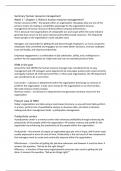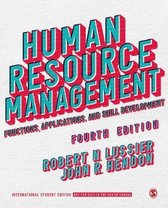Summary human resource management
Week 1 – Chapter 1: What is human resource management?
Human resources (HR) – the people within an organiza8on. Nowadays they are one of the
primary means of crea8ng a compe88ve advantage for the organiza8on because
management of human resources directly affects company performance.
This is because most organiza8ons of comparable size and scope within the same industry
generally have access to the same material and facili8es-based resources. This frequently
leaves people as the organiza8on’s most valuable asset.
Managers are responsible for geFng the job done through employees, so if you can get the
employees fully commiIed and engaged, we can make beIer decisions, increase employee
trust and loyalty, and improve produc8vity.
Employee engagement is a combina8on of job sa8sfac8on, ability, and a willingness to
perform for the organiza8on at a high level and over an extended period of 8me.
HRM in the past
Around the mid-19070s the human resource manager was considered to be an easy
management job. HR managers were expected to be only paper pushers who could correctly
and legally maintain all of the personnel files. In these past organiza8ons, the HR department
was considered to be a cost center.
Cost center - a division or department within the organiza8on that brings no revenue or
profit for the organiza8on. It only costs money for the organiza8on to run this func8on.
We need revenue centers instead.
Revenue centers - are divisions or departments that generate monetary returns for the
organiza8on.
Present view of HRM
Today’s organiza8ons are likely using a team-based structure, so you will most likely perform
in a team, perform lots of quan8ta8ve analysis on business data, and share in decision
making and other management tasks – par8cipa8ve management.
Produc'vity centers
A produc8vity center is a revenue center that enhances profitability through enhancing the
produc8vity of the people within the organiza8on. HR creates revenue and profits for the
organiza8on by enhancing the produc8vity of the people within the organiza8on.
Produc8vity – the amount of output an organiza8on gets per unit of input, with human input
usually expressed in terms of units of 8me. Produc8vity is the end result of two components
that managers work to create and con8nually improve within the organiza8on:
Effec8veness – a func8on of geFng the job done whenever and however it must be done. It
answers the ques8on, “did we do the right things?”
Efficiency – a func8on of how many organiza8onal resources were used in geFng the job
done. It answers the ques8on, “did we do things right?”
,Both of these are important, but most of the 8me, we are focused on efficiency.
Technology’s effect on efficiency
Senior HR managers have learned that one way to improve of their workers is through use of
technology and especially through the use of people analy8cs. Using technology allows us to
gather, analyze, and manage large amounts of data much more quickly than we have ever
been able to do before. This, in turn, allows managers to find commonali8es in the data that
can help them create new and more efficient processes, as well as more engaged employees.
Example
The Financial Times notes in an ar3cle that a4er Bank of America ou:i;ed their employees in
a call center with badges that monitored how they moved about the office, who they talked
to, and for how long, the company “discovered that its more produc3ve workers were those
allowed to take their breaks together, in which they let off steam and shared 3ps about
dealing with frustrated customers. The bank took heed and switched to collec3ve breaks,
a4er which performance improved 23 percent and the amount of stress is workers’ voices fell
19 percent.
The changing world of HRM
Labor demographics
Demographic changes in the labor force will significantly affect companies over the next 20
years. Companies in developed countries are seeing a reduc8on in the number and quality of
poten8al skilled employees, as well as greater gender, ethnic, and age diversity than at any
8me in the past. The lack of skilled professionals is an ongoing, worldwide problem.
Knowledge workers and the pace of change
In the now-mature Informa8on Age, we are managing a different kind of worker. A
knowledge worker. Knowledge is precious in an organiza8on.
Knowledge workers – workers who use their head more than their hands and who gather
and interpret informa8on to improve a product or process for their organiza8ons.
One of the most cri8cal issues HR managers face is the fact that technology is outpacing our
ability to use it at an ever-increasing rate. Computers get faster and faster, but the human
beings who have to use them don’t.
This means that if the people in our organiza8on can figure out ways to take advantage of
the technology beIer and quicker than our compe8tors can, then we can create a
sustainable compe88ve advantage.
According to DeloiIe, a leading interna8onal consul8ng company, it is important not to lose
sight of the fact that for most companies, human beings are the fundamental unot of
economic value.
Understanding HR’s criGcal factors
There are four things that are considered as the most important and most difficult things to
deal with: produc8vity, employee engagement, turnover and absenteeism.
,Turnover – permanent loss of workers from the organiza8on. When people quit, it is
considered voluntarily turnover, while when people are fired, it is involuntarily turnover.
Absenteeism – temporary absence of employees from the workplace. It is the failure of an
employee to report to the workplace as scheduled.
You can’t force an employee to come to work and thus avoid absenteeism, nor van we force
an employee to be fully engaged with their work. You have to create condi8ons in which the
employee is willing to or even wants to com e to work and in which they can enjoy their job.
There is strong evidence that turnover can have important consequences for organiza8onal
produc8vity and performance, as well as compe88ve advantage.
The four dependent variables men8oned above are interrelated. Absenteeism is costly, is
oden due to a lack of employee engagement, and leads to lower produc8vity. People tend to
leave their jobs (turnover) when they aren’t engaged with their work, and during the process
of replacing them produc8vity goes down.
The importance of strategic HRM
HR management must be proac8ve in nature. Good HR managers are constantly looking at
processes within the organiza8on and, if there is something wrong, figuring out how to assist
the line management team in fixing the problem.
The func8on of HR has been redesigned to enhance to other func8ons of the business.
Sustainable compe88ve advantage – a capability that creates for customers that rivals can’t
copy quickly or easily and that allows the organiza8on to differen8ate its products or services
from those of compe8tors.
The influence of social media
The recrui8ng process in many companies has almost been taken over by social media.
Recruiters scour social-media plaforms like LinkedIn for talented individuals whose profile fit
a job the recruiter is aIemp8ng to fill.
Selec8on may be supported by Skype interviewing. Other social media sites, like Facebook
and LinkedIn, are frequently scoured as part of the background check done on candidates to
help the company make a selec8on that fits with the organiza8onal culture.
Once the person is selected to join the organiza8on, social media can be used to assist in
many steps needed to get the person up to speed and capable of contribu8ng to the
company. It can be used to teach organiza8onal culture; create an FAQ area to answer
common ques8ons from new employees.
Social media plaforms give companies the means for con8nuous feedback to their
employees. Many employees respond beIer to con8nuing feedback than to quarterly or
annual formal appraisal sessions.
, HRM skills
The set of necessary HR skills is similar to the skills needed by other managers, but it
emphasizes people skills more than some other management posi8ons do. The Society for
Human Resource Management (SHRM) created the SHRM competency model, which
discusses four basic “competency clusters” that match up well with the following four skill
sets: technical skills, business skills, interpersonal skills, conceptual and design skills.
Technical skills – the ability to use methods and techniques to perform a task. Including
computer skills; training knowledge and skills; understanding of performance appraisal
processes’ cultural knowledge.
Interpersonal skills – the ability to understand, communicate, and work well with individuals
and groups through developing effec8ve rela8onships. You need to be good with people to
help bring out the best in people – Richard Branson. You need to be empathic.
Empathy is the ability to put yourself in another person’s place, to understand not only what
that person is saying but why the individual is communica8ng that informa8on to you.
Conceptual and design skills – the ability to evaluate a situa8on, iden8fy alterna8ves, select a
reasonable alterna8ve, and make a decision to implement a solu8on to a problem. This skill
set is a cri8cal part of crea8ng and maintaining the ability to lead in an organiza8on.
Business skills – the analy8cal and quan8ta8ve skills, including in-depth knowledge of how
the business works and its budge8ng and strategic planning processes, that are necessary for
a manager to understand and contribute to the profitability of the organiza8on.
Line versus staff management
Line managers are the individuals who create, manage, and maintain the people and
organiza8onal processes that create whatever it is that the business sells. They are the
people who control the actual opera8ons of the organiza8on.
Staff managers are the individuals who advise line managers in some field of exper8se. These
managers act basically as internal consultants for the company, within their fields of
specialized knowledge.
What does a line manager need to know about HR management?
Legal considera8ons, labor cost controls, leadership and mo8va8on, training and
development, appraisal and promo8on, safety and security of employees.
HR managers’ responsibiliGes: disciplines within HRM
Most HR jobs are either generalist jobs, in which the HR employee works in many different
areas, or specialist jobs, in which the employee focuses on a specific discipline of HR.
Small businesses tend to have more generalist HR managers, versus more specialists in larger
organiza8ons.
A list of specialist careers: the legal environment, EEO and diversity management, staffing,
training and development, employee and labor rela8ons, compensa8on and benefits, safety
and security, ethics, people analys8cs.






